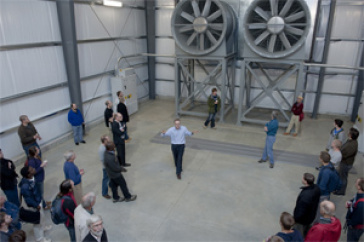Slow Flow: New Wind Tunnel is Largest of Its Type

Flow Physics Facility director Joe Klewicki, professor of mechanical engineering at the University of New Hampshire, introduces the new facility to alumni of the College of Engineering and Physical Sciences. Photo: Mike Ross, UNH Photographic Services
DURHAM, N.H. - The University of New Hampshire is now home to a wind tunnel that is the largest of its type in the world.
At 300 feet long, the new Flow Physics Facility (FPF) is the world's largest scientific quality boundary-layer wind tunnel facility. It will help engineers and scientists better understand the dynamics of turbulent boundary layers, informing the aerodynamics of situations such as atmospheric wind over the ocean, the flow of air over a commercial airplane or of sea water over a submarine.
Two 400-horsepower fans, each moving 250,000 cubic feet of air per minute, can generate a wind of approximately 28 miles per hour in the facility. The relatively low velocity of wind generated over a great distance makes for greater accuracy in measuring the turbulence that develops in a specific class of flows known as high Reynolds number flows.
"The philosophy behind this facility is the big and slow approach," says Joe Klewicki, professor of mechanical engineering and director of the Center for Fluid Physics, as well as outgoing dean of the College of Engineering and Physical Sciences.
"Turbulence is often called the last unsolved problem in classical physics, and our lack of understanding has many adverse effects, from weather prediction to engineering design and practice," says assistant professor of mechanical engineering Martin Wosnik, who helped design the facility with Klewicki, assistant professor of mechanical engineering Chris White, and research professor Jim Forsythe. "This new facility will help us test, for the first time, new theories that are emerging to update the classical views of turbulence, which date from the 1930s and '40s."
Researchers from UNH and beyond will use the facility to explore the aerodynamics of, for instance, the junction of the wing and fuselage on an airplane. "This is a huge issue for aircraft companies, because it enables them to better predict or even manipulate fuel economy," says Klewicki. Or by placing a model cityscape on a turntable in the wind tunnel, engineers could model how the release of a chemical into the atmosphere would flow around buildings.
The wind tunnel is also ideally suited for human-scale aerodynamic studies, says Klewicki. By positioning athletes like skiers or bicyclists in the tunnel, scientists and coaches could improve helmet design, posture, or pedaling position for maximum efficiency. For elite competitors, "the smallest change in where your knee is when you pedal, for instance, can mean the difference between finishing first or fifth," says Klewicki.
The FPF, which is on Waterworks Road on the eastern edge of campus, is essentially a rectangular box, 300 feet long by 20 feet wide. The fans create suction that pulls air through open garage-style doors on the opposite end of the facility: "Unless both garage doors are open, the fans won't run. Without such precautions one could cause damage to the structure," says Klewicki.
Other features of the facility, which cost $3 million, are a 10-inch-thick poured concrete floor; moisture-proof walls; windows designed to accommodate laser measurement from the outside; a turntable; and drag plates on the floor for measuring aerodynamic force, as on an airplane.
Funding for the FPF was provided by the National Science Foundation through EPSCoR (Experimental Program to Stimulate Competitive Research), the Office of Naval Research, and UNH.
The University of New Hampshire, founded in 1866, is a world-class public research university with the feel of a New England liberal arts college. A land, sea, and space-grant university, UNH is the state's flagship public institution, enrolling 12,200 undergraduate and 2,300 graduate students.
-30-
Photographs available to download:
/unhtoday/news/cj_nr/2010/nov/bp08tech_01.jpg
Caption: Flow Physics Facility director Joe Klewicki, professor of mechanical engineering at the University of New Hampshire, introduces the new facility to alumni of the College of Engineering and Physical Sciences.
/unhtoday/news/cj_nr/2010/nov/bp08tech_03.jpg
Flow Physics Facility director Joe Klewicki, professor of mechanical engineering at the University of New Hampshire, in front of the two 400-horsepower fans that each move 250,000 cubic feet of air per minute
/unhtoday/news/cj_nr/2010/nov/bp08tech_02.jpg
An exterior view of UNH's new Flow Physics Facility.
Credit: All photos by Mike Ross, UNH Photographic Services.
Reporters and editors: Center for Fluid Physics director Joe Klewicki, professor of mechanical engineering at UNH, is available at mailto:joe.klewicki@unh.edu"
Latest News
-
October 8, 2025
-
October 2, 2025
-
September 24, 2025
-
September 15, 2025
-
August 21, 2025














































